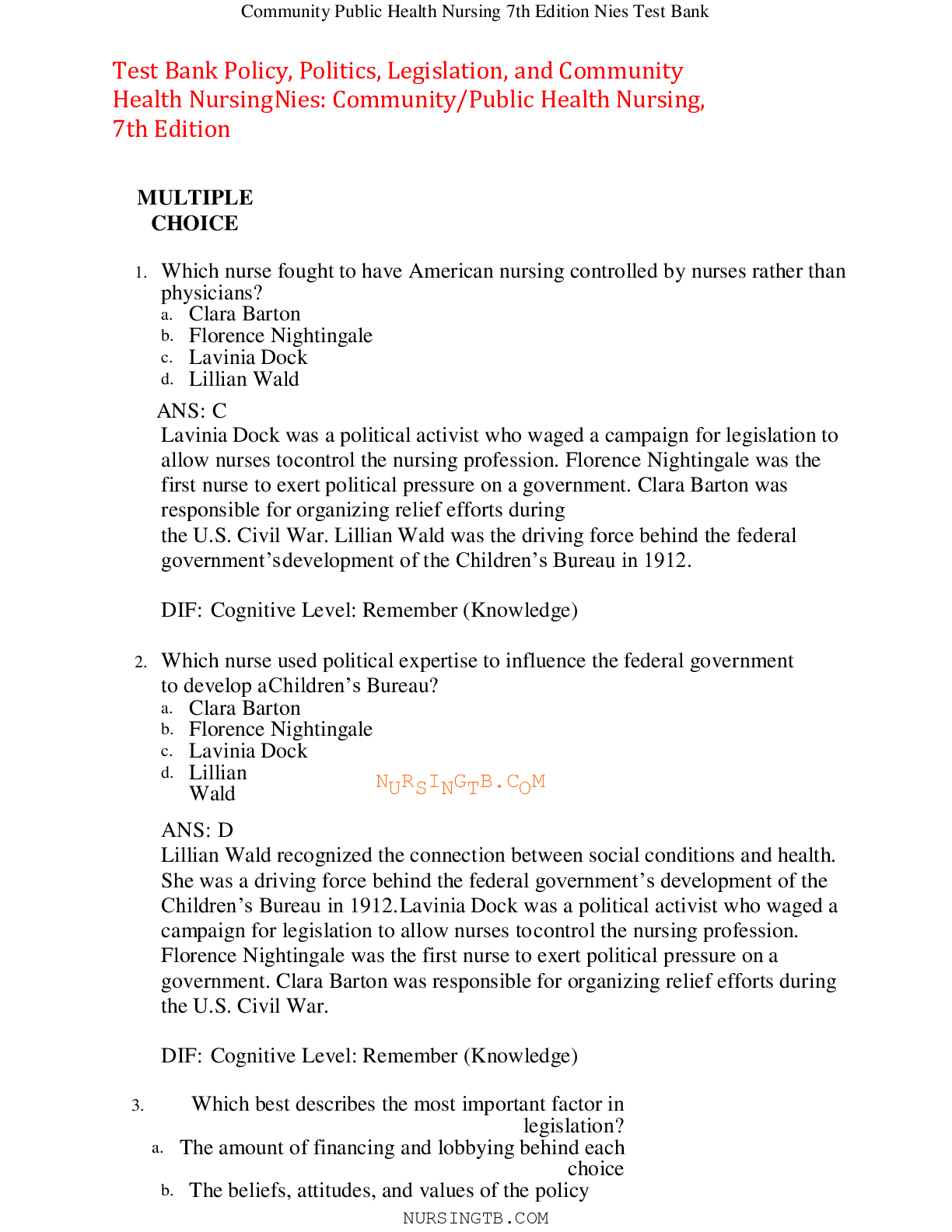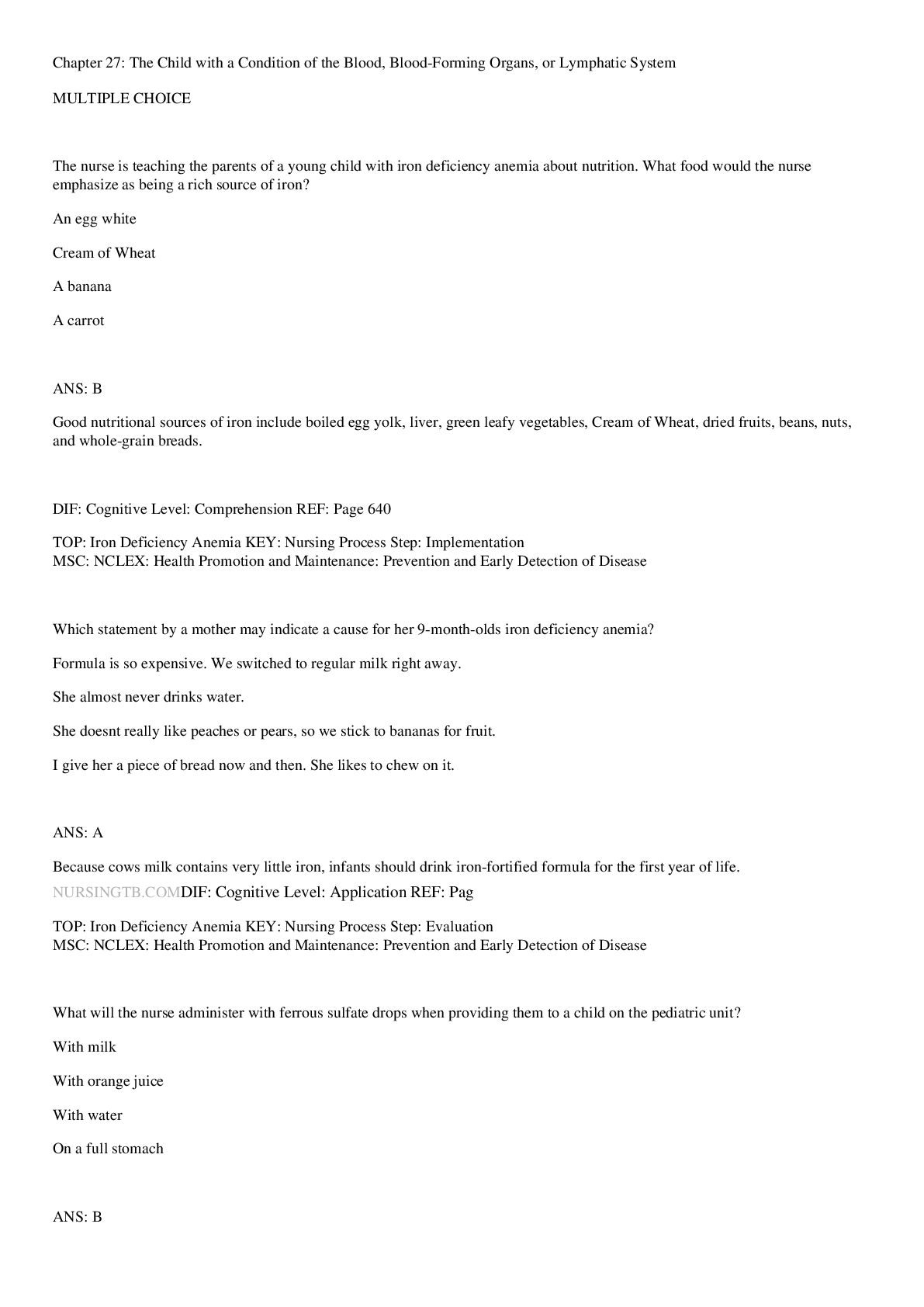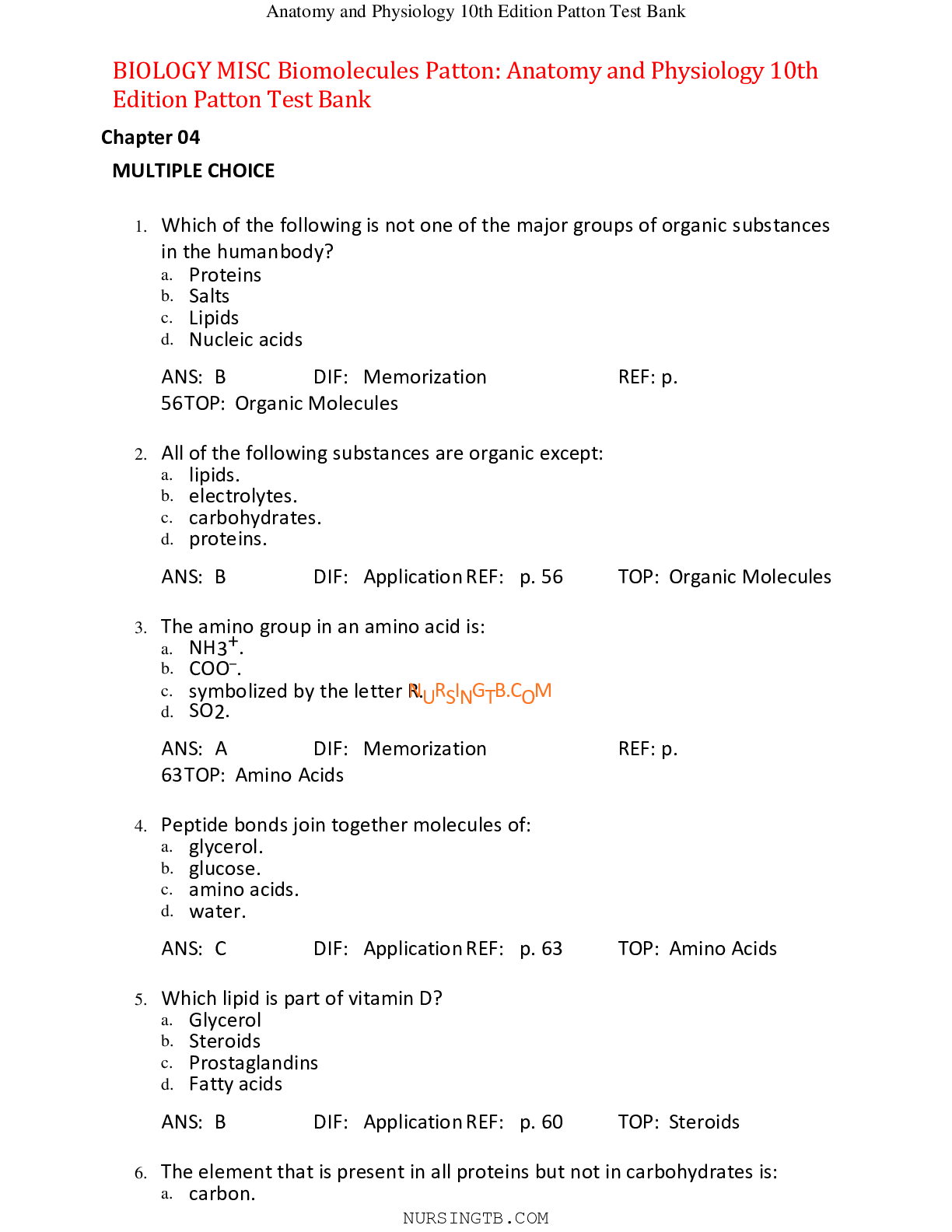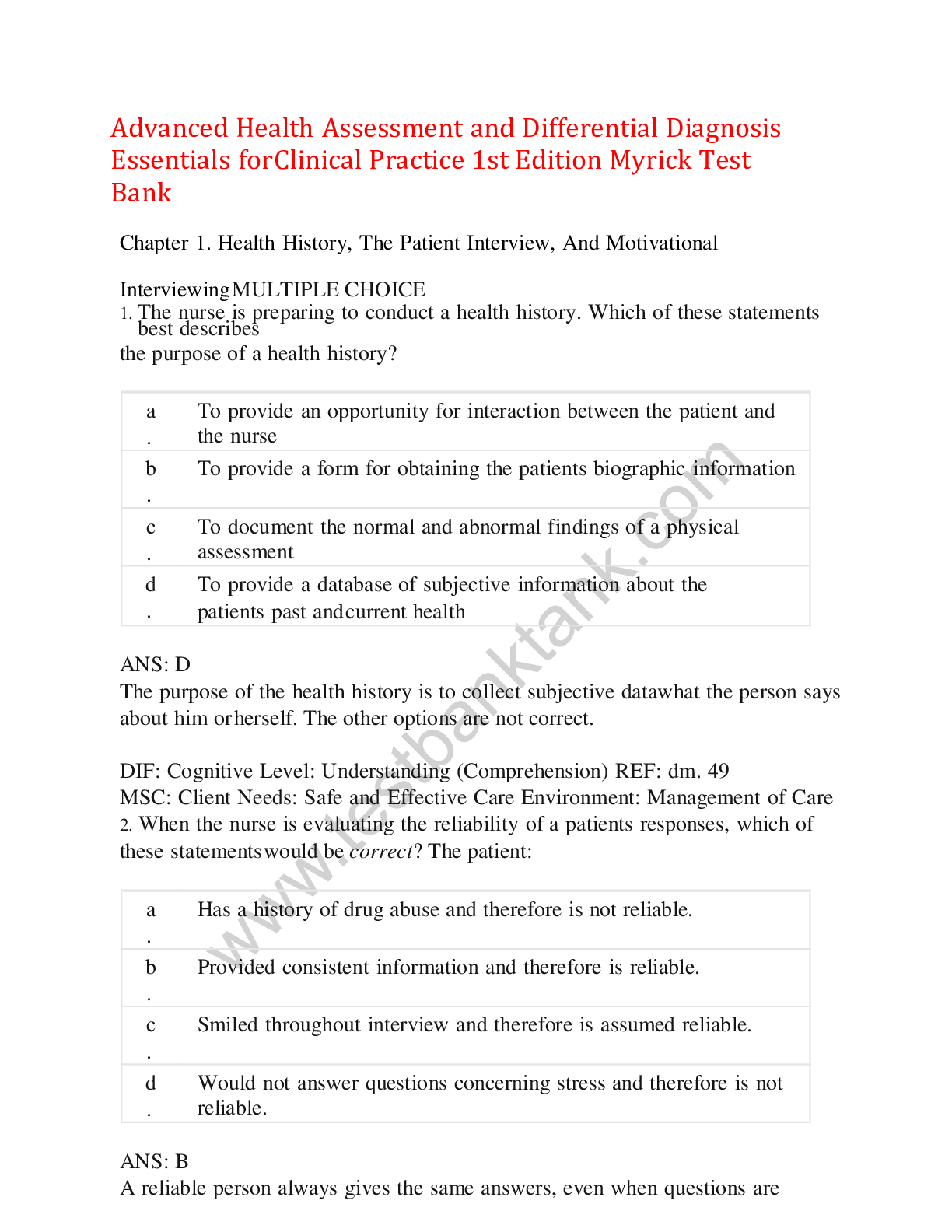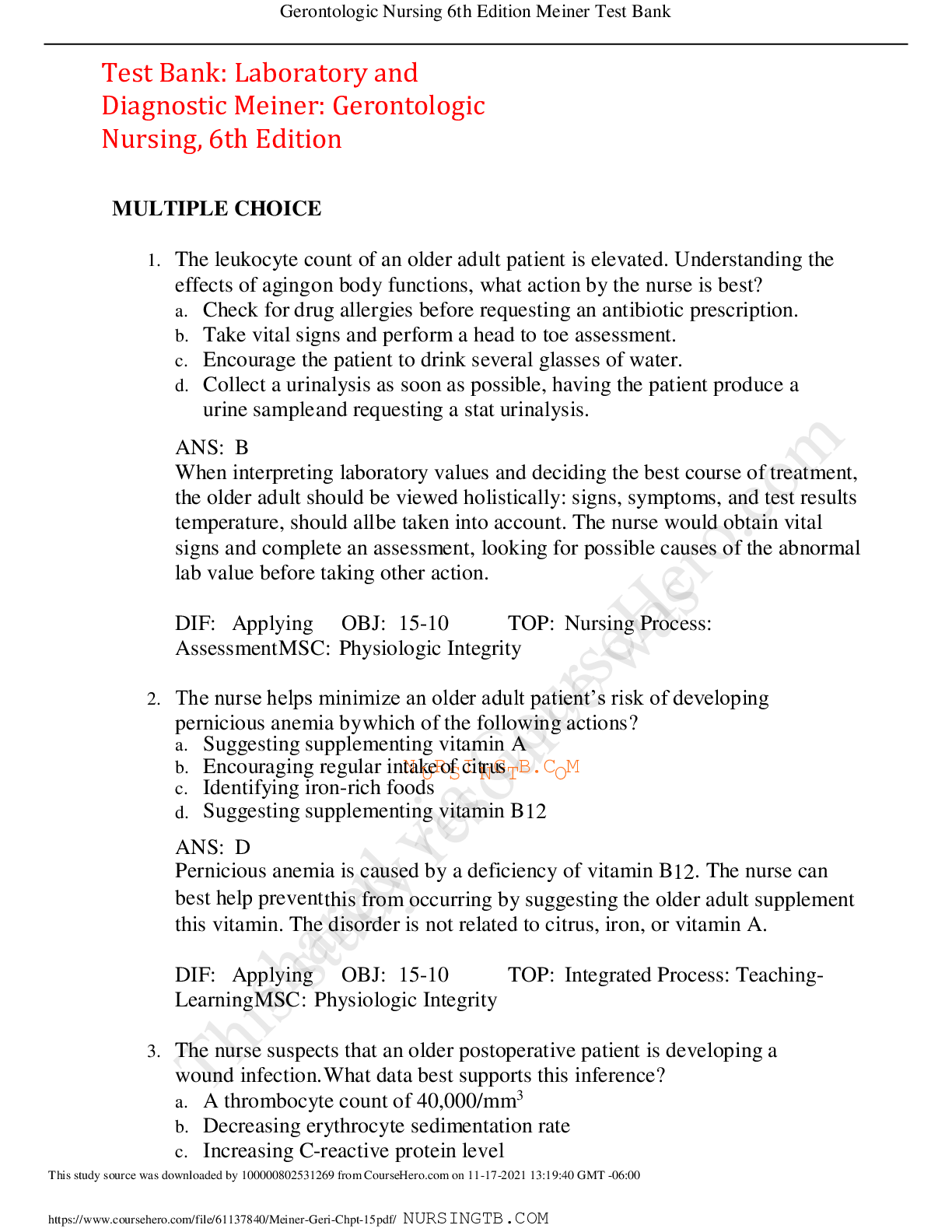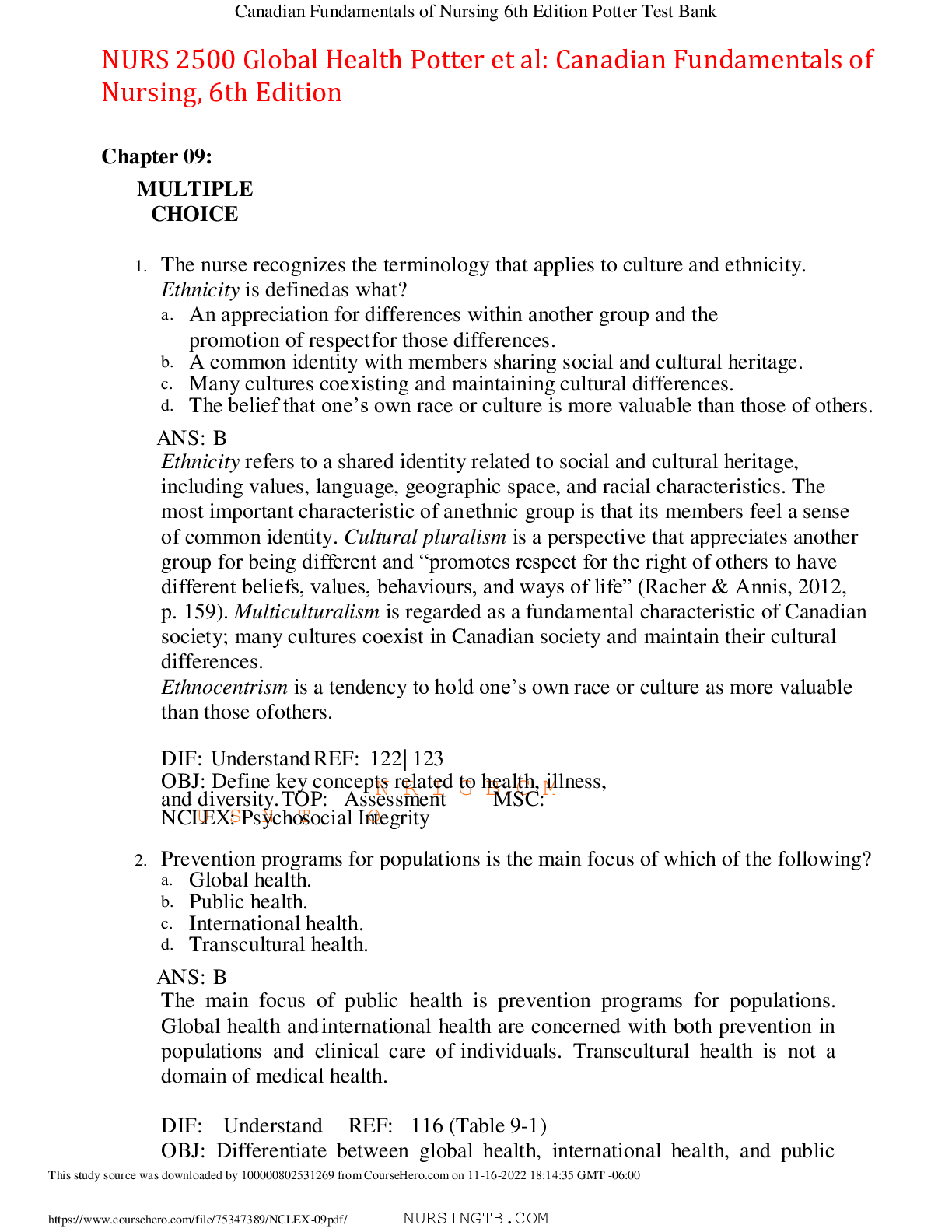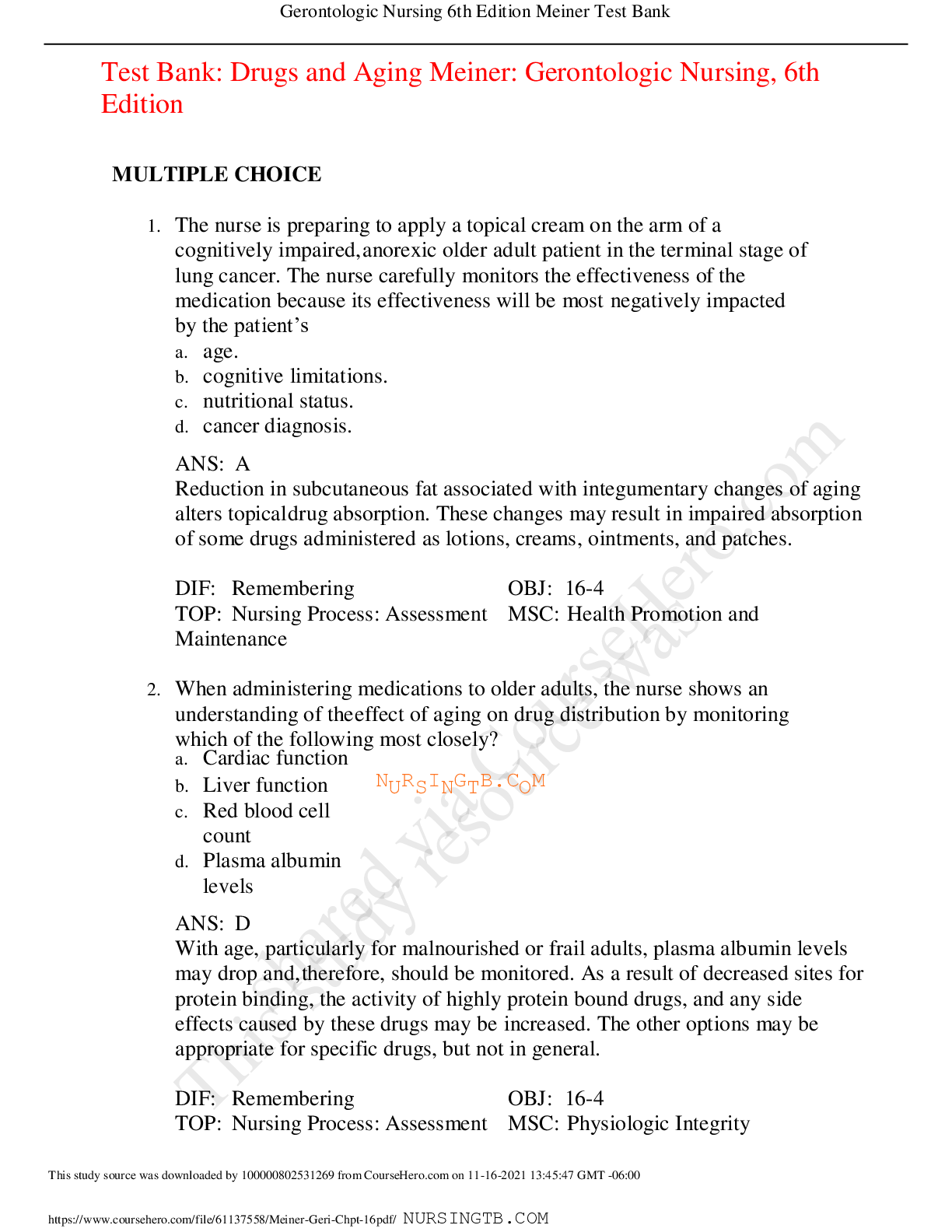*NURSING > TEST BANK > Test Bank: Socioeconomic and Environmental Influences Meiner: Gerontologic Nursing, 6th Edition,100% (All)
Test Bank: Socioeconomic and Environmental Influences Meiner: Gerontologic Nursing, 6th Edition,100% CORRECT
Document Content and Description Below
Test Bank: Socioeconomic and Environmental Influences Meiner: Gerontologic Nursing, 6th Edition MULTIPLE CHOICE 1. To best respect an older patient’s autonomy when assisting him in finding a... ppropriate, affordable housing, the nurse takes which action? a. Provides examples of various options that include assistive services. b. Locates housing near a senior citizen community center to minimize social isolation. c. Identifies housing close to the services he will need. d. Asks the patient to provide examples of where he would like to live. ANS: D Whatever the housing status of the older person, it must be remembered that each person has a right to determine where to live unless he or she is proven incompetent. The other options do not help the patient maintain autonomy. DIF: Applying OBJ: 7-5 TOP: Nursing Process: Assessment MSC: Safe and Effective Care Environment 2. A nurse working with older adults recognizes that the patient at greatest risk for homelessness is the a. female with a psychiatric diagnosis. b. male with a chronic illness. c. female with a history oNf socRial IisolGatioBn..C M d. male with an alcohol abuse issue. ANS: A Women are increasing in numbers among the homeless older adult communities. Approximately 30% of homeless older adults have mental illness or dementia. DIF: Remembering OBJ: 7-1 TOP: Nursing Process: Assessment MSC: Safe and Effective Care Environment 3. A nurse volunteers at a facility that provides free lunches for older adults. To minimize the tendency of these patients to withdraw socially, what action by the nurse is best? a. Frequently reinforces that everyone is welcome to have lunch with the group. b. Makes every effort to engage them in conversation during the meal. c. Encourages them to make friends with the other diners. d. Asks if they would assist those who need help with getting their food. ANS: D Older adults tend to feel an obligation to return favors. If someone does something for them, such as helping them to get their food, they want to be able to reciprocate. Being able to assist others increases the older person’s self-esteem. The other choices are appropriate actions, but not the best choice for decreasing isolation. DIF: Applying OBJ: 7-1 TOP: Nursing Process: Implementation MSC: Psychosocial Integrity 4. A 69-year-old patient who has both Medicare and long-term supplemental health care insurance shares with the nurse that he is in need of a visual examination as a follow-up after his cataract surgery. The nurse suggests that such treatment is most likely covered by a. Medicare Part A. b. Medicare Part B. c. Medicare Part D. d. Supplemental policy. ANS: B A vision examination is a physician service covered by Medicare Part B. DIF: Remembering OBJ: 7-4 TOP: Nursing Process: Assessment MSC: Safe and Effective Care Environment 5. The nurse recognizes that health and wellness are better among the educated older adult population because they tend to a. place a high value on health and wellness. b. frequently take advantage of health screening options. c. have occupations that are less physically demanding. d. manage emotional stress in a more productive manner. ANS: B More-educated people often have greater access to wellness programs and preventive health options because they tend to have more financial resources and health insurance coverage. Education may lead to an increased value on health and wellness. Occupations may or may not be physically demandingU. EdSucaNted Tolder adOults may not manage stress more productively. DIF: Remembering OBJ: 7-1 TOP: Integrated Process: Teaching-Learning MSC: Health Promotion and Maintenance 6. Which patient is most likely to be seen at a clinic that services older adults who are at or below the poverty level? a. A Hispanic male living with extended family b. An African American male living with a spouse c. A Hispanic female who lives alone d. An African American female who lives with her sister ANS: C The highest rates of poverty are among Hispanic women over the age of 65 who live alone. DIF: Remembering OBJ: 7-3 TOP: Nursing Process: Assessment MSC: Health Promotion and Maintenance 7. The nurse is addressing a senior citizens group that is composed of members who are 75 years of age and older. The nurse expects that the group will be primarily a. widows who have never worked outside of their homes. b. widowers with at least one chronic illness. c. females who have part-time jobs. d. males with pensions plus Social Security income. ANS: A After age 75, women outnumber men in American society. Most women in this age group did not work outside the home, so their incomes depend on their spouses’ pensions or Social Security benefits. DIF: Remembering OBJ: 7-1 TOP: Nursing Process: Assessment MSC: Health Promotion and Maintenance 8. A patient who grew up during the 1930s in an urban community has been prescribed several medications for a variety of chronic health issues. To help ensure medication compliance based on knowledge of this age cohort, what action by the nurse is best? a. Provides a detailed explanation about the importance of taking the medications appropriately. b. Educates the patient about the cost-effectiveness of generic brands of the prescribed medications. c. Includes family members with the patient in the medication education plan. d. Offers suggestions on ways to minimize the risk of “forgetting” to take medication correctly. ANS: B Persons of this cohort (raised during the American depression of the 1930s) are generally frugal and often do not spend money, even if they have it. Suggesting a cost-effective way to purchase the medicationNs wiRll paIrticGularBly.aCppeMal to this patient. U S N T O DIF: Understanding OBJ: 7-2 TOP: Integrated Process: Teaching-Learning MSC: Health Promotion and Maintenance 9. The nurse who works with veterans from the 1940s and 1950s knows that individuals in this cohort are more likely than older adults to a. obtain preventative health services. b. hoard money for times of need. c. work hard to keep families intact. d. be noncompliant with medications. ANS: A Women and men who served in the armed forces during this time became accustomed to preventive medical and dental care. Those influenced by the Great Depression are more likely to hoard money. Families started becoming more mobile in this cohort. This cohort is not as likely to be noncompliant because of cohort influences. DIF: Remembering OBJ: 7-2 TOP: Nursing Process: Assessment MSC: Health Promotion and Maintenance 10. An older patient appears to have few friends and little family. What action by the nurse is best? a. Encourage the patient to stay in contact with remaining family members. b. Help the patient find new social outlets and support systems. c. Assess the patient for depression or substance abuse. d. Ask the patient why there are so few friends and family. ANS: B Social networks are invaluable to help mitigate the effects of major life events on health. The nurse can encourage the patient to join groups or organizations in order to make new friends. Staying in touch with family may or may not be desired. The patient may need assessment for substance abuse, but this is not the best action. Asking “why” questions often puts people on the defensive, and this technique is not considered a therapeutic communication tool. DIF: Applying OBJ: 7-5 TOP: Integrated Process: Communication and Documentation MSC: Psychosocial Integrity 11. An adult child of an older adult confides in the nurse that the patient has lost most of her friends because of her negative behavior. What action by the nurse is best? a. Ask when the patient had her last physical exam. b. Encourage the patient to be more positive. c. Ask if the patient is aware of the problem. d. Suggest the patient take antidepressants. ANS: A Depressed or negative older adults have trouble maintaining relationships. There may be a physical problem contributing to the patient’s emotional state. The other answers do not provide action that could posUsiblSy alNleviTate the sOituation. Giving the patient medications without a full workup is dangerous. DIF: Applying OBJ: 7-5 TOP: Nursing Process: Assessment MSC: Physiologic Integrity 12. A patient is not competent to manage financial affairs. What legal recourse does the older person have? a. Guardian b. Conservator c. Health care proxy d. Social worker ANS: B A conservator is appointed by the courts to handle a patient’s monetary affairs. A guardian helps with nonmonetary issues. Health care proxy and social workers do not manage financial affairs. DIF: Remembering OBJ: 7-6 TOP: Integrated Process: Teaching-Learning MSC: Safe and Effective Care Environment 13. An older couple is considering moving into a retirement community. What reaction by the nurse is best? a. “That’s a good idea to consider at your age.” b. “Check on what levels of care they provide.” c. “Do you have enough money to afford this?” d. “What does your family think of this idea?” ANS: B Retirement communities have differing levels of care; some are only for independent seniors, whereas others offer an array of arrangements. This is the most important factor for the couple to consider, because they may face having to move to another community as their needs change. Finances will be an important consideration, but yes/no questions are not therapeutic. Telling the couple that moving is a good idea “at your age” shows ageism. Family opinions may or may not matter to the couple, but they are not the priority. DIF: Applying OBJ: 7-8 TOP: Integrated Process: Teaching-Learning MSC: Psychosocial Integrity 14. An older adult is planning to move to an assisted living facility. What advice does the nurse provide to the adult children? a. “Let your father choose what items to take with him.” b. “Warn your dad there will be little room for personal things.” c. “It is best to pick your dad up one day and move him in.” d. “Be aware your dad may suffer from depression or confusion.” ANS: A Individuals who move can suffer from relocation stress, which is a negative consequence of moving. If the patient has inpUut iSnto Nthe TfacilityOchosen, can take tours, and can bring cherished personal items with him or her, the chances of relocation stress lessen. Although there might be limited room, it is more important for the family to let the patient take wanted items. Moving precipitously can increase the chance of relocation stress. The family should be warned about the negative reactions to moving that are possible, but this does not give them the ability to lessen the impact. DIF: Applying OBJ: 7-5 TOP: Integrated Process: Teaching-Learning MSC: Psychosocial Integrity 15. An adult daughter brings a patient to the gerontology clinic and reports that the patient has become increasingly withdrawn and no longer goes out during the day. What response by the nurse is best? a. Administer a Mini–Mental State Examination. b. Ask the patient why this is happening. c. Assess if the patient feels safe at home. d. Determine if abuse is occurring. ANS: C Patients often withdraw and become isolated when they do not feel safe in their surroundings. The nurse should first assess the patient’s perception of safety. The other options may or may not be necessary, but “why” questions should be avoided, as they generally place people on the defensive. DIF: Applying OBJ: 7-7 TOP: Nursing Process: Assessment MSC: Psychosocial Integrity 16. An older woman lives alone. What action by the nurse is best to keep the patient from becoming a victim of crime? a. Encourage the patient to take self-defense classes. b. Tell the patient that it is okay to hang up or not answer the door. c. Have the patient install a monitored security system. d. Ask if there is a neighbor who can check up on her. ANS: B Older people who are lonely may welcome “visits” from unscrupulous visitors. They are also less likely to hang up the phone or close the door to avoid appearing impolite. The nurse can best help this patient by telling her such behavior is not only all right, it is important for her safety. The other actions are also possible but can be costly, and the patient may not have a reliable neighbor. DIF: Applying OBJ: 7-10 TOP: Integrated Process: Teaching-Learning MSC: Safe and Effective Care Environment 17. The nurse is presenting an educational workshop at a senior center where most of the patients will be 75 years or older. What does the nurse consider about this population when designing the presentation? a. Most of these patients only have a high school diploma. b. Many patients will be illiterate so handouts should be simple. c. A great number of patieNntsRnevIer aGttainBe.d Ca hiMgh school. d. A lot of these patients went to college on the GI bill. ANS: A Educational attainment differs with age cohorts. In this age group, the highest number of persons attained a high school diploma. DIF: Remembering OBJ: 7-2 TOP: Integrated Process: Teaching-Learning MSC: Health Promotion and Maintenance MULTIPLE RESPONSE 1. When preparing an educational program focused on chronic illnesses that at least a third of the older adult population is likely to experience, the nurse includes information on which of the following? (Select all that apply.) a. The benefit of aquatic exercise b. Signs and symptoms of cataracts c. Ways to control sodium intake d. Latest technologic interventions for hearing loss e. The effects of exercise on cardiovascular health ANS: A, C, E The most common chronic problems in 2015 were heart disease, cancer, chronic obstructive pulmonary disease (COPD), stroke, Alzheimer’s disease, and diabetes. These exercise and diet programs can have a positive influence on these common conditions. Cataracts and hearing loss are not included. DIF: Understanding OBJ: 7-1 TOP: Integrated Process: Teaching-Learning MSC: Health Promotion and Maintenance 2. The nurse is educating an 80-year-old patient regarding a newly prescribed medication. The nurse’s teaching strategies include which of the following? (Select all that apply.) a. Use pictures to show how the medication should be stored. b. Ask the patient to use his own words to describe the medication’s possible side effects. c. Avoid written instruction in favor of verbal, face-to-face communication. d. Deliver the information using a slow, deliberate manner of speech. e. Repeat the information at least three times during the conversation. ANS: A, B, E Strategies such as repetition, patient restating, and varied delivery methods such as pictures, written, audio, and oral discussion are all appropriate and recommended for the older adult learner. DIF: Understanding OBJ: 7-1 TOP: Integrated Process: Teaching-Learning MSC: Health Promotion and Maintenance N R I G B.C M 3. The nurse who volunteers at a community center for older people refers which people to the Supplemental Security Income office? (Select all that apply.) a. Disabled persons b. Those who are visually impaired c. Deaf persons d. Those with minimal income e. Those who are cognitively impaired ANS: A, B, D Individuals who are eligible for SSI include those who are very old, disabled, visually impaired, and have minimal income or assets. Being deaf or cognitively impaired are not criteria. DIF: Remembering OBJ: 7-3 TOP: Integrated Process: Communication and Documentation MSC: Safe and Effective Care Environment [Show More]
Last updated: 1 year ago
Preview 1 out of 14 pages

Reviews( 0 )
Document information
Connected school, study & course
About the document
Uploaded On
Nov 21, 2021
Number of pages
14
Written in
Additional information
This document has been written for:
Uploaded
Nov 21, 2021
Downloads
0
Views
41

